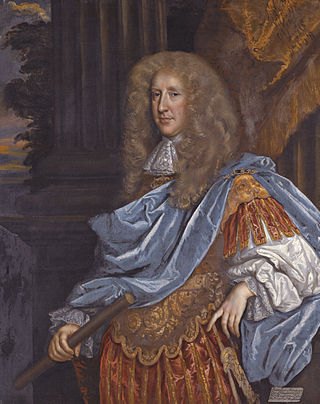
Earl Ferrers is a title in the Peerage of Great Britain. It was created in 1711 for Robert Shirley, 14th Baron Ferrers of Chartley. The Shirley family descends from George Shirley of Astwell Castle, Northamptonshire. In 1611 he was created a Baronet, of Staunton Harold in the County of Leicester, in the Baronetage of England. He was succeeded by his son Henry, the second Baronet, who married Lady Dorothy Devereux, daughter of Robert Devereux, 2nd Earl of Essex. On the death of her brother Robert Devereux, 3rd Earl of Essex, she became the youngest co-heir to the baronies of Ferrers of Chartley and the barony of Bourchier, which had fallen into abeyance on the death of the third Earl. Shirley was succeeded by his eldest son, the third Baronet. He died unmarried and was succeeded by his younger brother, the fourth Baronet. He was imprisoned in the Tower of London by Cromwell and died there in 1656. On his death the title passed to his eldest son, the fifth Baronet. He died at an early age and was succeeded at birth by his posthumous son, the sixth Baronet.
Earl of Sussex is a title that has been created several times in the Peerages of England, Great Britain, and the United Kingdom. The early Earls of Arundel were often also called Earls of Sussex.

Robert Bruce, 1st Earl of Ailesburyand 2nd Earl of Elgin, PC, FRS, was a Scottish politician who sat in the House of Commons from 1660 to 1663, when he inherited his father's title as Earl of Elgin.

Sir Walter St John, 3rd Baronet, of Lydiard Tregoze, Wiltshire, and of Battersea, was an English MP.
Sir Thomas Temple, 1st Baronet was an English proprietor and governor of Acadia/Nova Scotia (1657–70). In 1662, he was created a Baronet of Nova Scotia by Charles II.

Sir John Glynne KS was a Welsh lawyer of the Commonwealth and Restoration periods, who rose to become Lord Chief Justice of the Upper Bench, under Oliver Cromwell. He sat in the House of Commons at various times between 1640 and 1660.

Sir Thomas Shirley, of Wiston in Sussex, was an English Member of Parliament, government official and courtier who is said to have suggested the creation of the title of baronet.

There have been two baronetcies created for members of the Burgoyne family, one in the Baronetage of England and one in the Baronetage of the United Kingdom. Both creations are extinct.

There have been two baronetcies created for persons with the surname Yelverton, both in the Baronetage of England.
John Ashburnham may refer to:
There have been two baronetcies created in the Baronetage of England for members of the Colepeper family of Kent and Sussex. Both are extinct.
Sir John Stapley, 1st Baronet of Patcham (1628–1701) was an English politician who sat in the House of Commons at various times between 1654 and 1679. He was a Royalist who plotted with members of the Sealed Knot to overthrow the Protector Oliver Cromwell and restore Charles II of England to the throne, but when questioned by Cromwellians he disclosed the plot and betrayed the other members. After the Restoration, he was created a baronet on 28 July 1660.
Sir John Fagg, 1st Baronet was an English politician who sat in the House of Commons of England at various times between 1645 and 1701. During the Civil War, he fought on the Parliamentarian side as a colonel in the New Model Army.
Sir John Meux, 1st Baronet was an English politician who sat in the House of Commons from 1640 to 1643. He supported the Royalist cause in the English Civil War.

Sir Baynham Throckmorton, 3rd Baronet of Clearwell, Gloucestershire was an English politician who sat in the House of Commons at various times between 1656 and 1679.
Sir Henry Peckham (1614–1673) was an English landowner, lawyer, judge, administrator, and politician who sat in the House of Commons as MP for Chichester in Sussex at various times between 1654 and 1673.
Sir Richard Grobham Howe, 2nd Baronet, was an English politician who sat in the House of Commons at various times between 1656 and 1695.
Sir Anthony Shirley, 1st Baronet was an English politician who sat in the House of Commons between 1654 and 1659.

Sir Edward Goodere, 1st Baronet of Burhope/Burghope House in the parish of Wellington, Herefordshire, was a British politician who sat in the House of Commons from 1708 to 1727. He was primarily a Tory, but in his first Parliament acted as a Whig.
Sir Thomas Hewett, 1st Baronet was an English landowner of the Civil War period, who briefly sat in Parliament for Windsor. He made his home at Pishiobury, which he bought in 1635.









